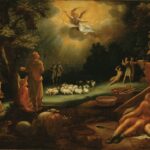Can I confess something? For a long time, I was scared of the first chapter of Hebrews. I had heard over and over again that it was one of the most powerful texts on the full divinity of Jesus, but when I read it, it seemed to be anything but that.
“In the past God spoke to our ancestors through the prophets at many times and in various ways, but in these last days he has spoken to us by his Son, whom he appointed heir of all things, and through whom also he made the universe. The Son is the radiance of God’s glory and the exact representation of his being, sustaining all things by his powerful word. After he had provided purification for sins, he sat down at the right hand of the Majesty in heaven. So he became as much superior to the angels as the name he has inherited is superior to theirs” (Hebrews 1:1-4 NIV).
There are certainly statements in these verses that sound like Jesus is God—Jesus made and sustains the universe. And then there is that statement that Jesus is “the radiance of God’s glory and the exact representation of his being.” Which sounds good, but what exactly does it mean? But along with those, this passage also speaks of Jesus being “appointed heir of all things” and becoming superior to the angels. To me, that didn’t sound like Jesus is fully divine, equal with his Father; it sounded like he became God’s Son at some point in the past.
I knew that was theologically incorrect, but I didn’t know how to square my good theology with what the Bible actually seemed to say, which scared me. I wish I could say that I dug into these verses right away so I could understand them, but I didn’t. I’m ashamed to say that I sort of just avoided them for a long time. It really is a shame, because when I finally did come to understand these verses, I saw how glorious they are.
The Literary Genius of Hebrews
The author of Hebrews was a skilled orator. He knew how to use language well and craft turns of phrases. These four verses are brilliantly put together in Greek. He uses alliteration and parallel sentences and all kinds of techniques to make this one long Greek sentence sound beautiful. Unfortunately, almost none of that comes through in the English translations. However, one of the author’s literary devices can still be seen in English.
These four verses are structured like a bullseye, or like an onion, where the outer layer at the beginning and end of the sentence can be peeled back to reveal the next layer and then the next layer until you get to the heart of the sentence, the bullseye, that tells us the most incredible truths about who Jesus is.
The Heart of Jesus’ Identity
The heart of these verses is that mysterious phrase at the beginning of verse 3: “The Son is the radiance of God’s glory and the exact representation of his being.” This is the core of who Jesus is, according to Hebrews 1. Jesus’ identity is described using two metaphors. The metaphors say slightly different things and we need to understand them together in order to begin to understand who Jesus is.
Understanding Divine Radiance
So first, Jesus “is the radiance of God’s glory.” God is called glorious all throughout the Bible. Glory speaks of God’s supreme goodness and beauty. This glorious beauty is so intense that we can’t get close to him or even look at him. Think of the sun. The sun’s pure light is so intense and strong that we can’t look directly at it or it will damage our eyes— that is an illustration of glory. But God’s glory is so much more than the glory of the sun or any other created thing.
The Perfect Representation
The second metaphor tells us that Jesus is “the exact representation of his [God’s] being.” The word “exact representation” in Greek is a word that is used to talk about stamping coins. If you have a coin mould and you stamp some metal, the exact representation of the mould is now on the coin. They look exactly the same. And that coin serves as a metaphor of Jesus who is exactly like God’s being. Everything that it is to be God is exactly in Jesus.
Wrestling with Mystery
At this point, you may be saying, “Right, this is a Trinity thing, that makes sense. But I still don’t get it.” I don’t blame you. A while back, my daughter wanted to pray for breakfast. She prayed, “Dear Jesus, thank you for my breakfast and for my baby sister and my big sister and my Mommy and my Daddy. And thank you that you are also the Father and the Holy Spirit. That’s crazy! How can you be the Father and the Son and the Holy Spirit? It’s like you’re all mixed up! In Jesus’ name, Amen.”
As cute as that was, it’s my daughter who was mixed up, not God. Thankfully, we can think more deeply about what the Bible teaches about the Trinity so that we have confidence in Jesus’ identity as God.
The Eternal Generation
In the Old Testament, when God revealed himself to Moses at the burning bush, he told Moses that his name is I AM (Exodus 3:14). Who is God? He is the one who IS. He is the one who exists, purely and without beginning or cause. God created the world and so he gave life to everything. But he wasn’t given life by anyone else, he simply IS. The being of God is perfect, pure, unending life in himself.
In John 5:26, Jesus makes a mind-boggling statement about that divine I AM life. “For as the Father has life in himself, so he has granted the Son also to have life in himself.” This is a paradox that we won’t be able to completely understand, but if we hold onto it as truth, it shows us how to speak of Father and Son as distinct persons who are one God. The divine I AM life of God belongs to Jesus and it is eternally given to him from his Father. The Father didn’t start giving the Son this life at some point so that Jesus became God at some point in time. While human fathers become fathers at a point in time when their children are conceived and born, God is eternally a Father and eternally a Son.[1]
Conclusion: Embracing the Mystery
It’s okay if your brain hurts a little bit after that. We should expect the deep things of God to stretch us beyond our capacity. But isn’t it a glorious truth? Jesus is the eternally begotten Son of God who has been granted to have I AM life in himself by his Father. The one being of God is eternally shared from Father to Son without division or multiplication of that being so that both are God without God being divided and without there being two Gods. Praise Jesus, “the radiance of God’s glory and the exact representation of his being.”
[1] The Holy Spirit’s relation to the Father and the Son is not called eternal begottenness (he is not a Son). It is called eternal procession, which describes how the Father and the Son together share the divine I AM life of God with the Spirit.























